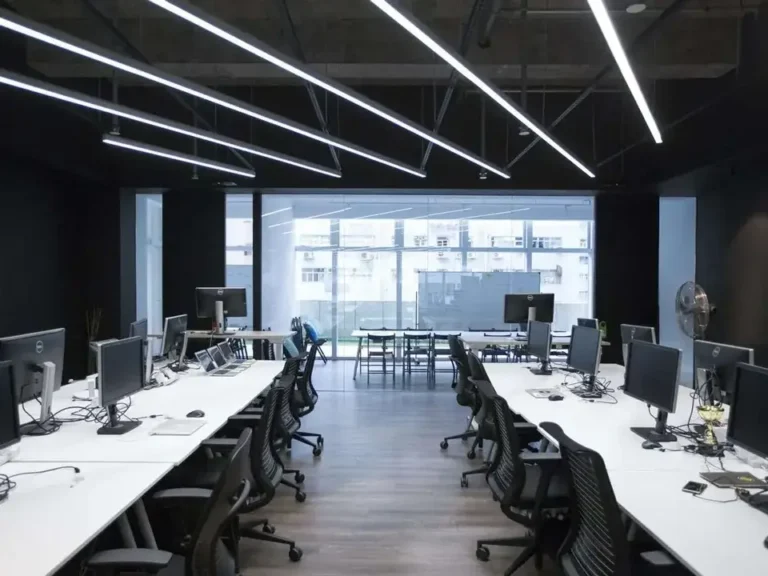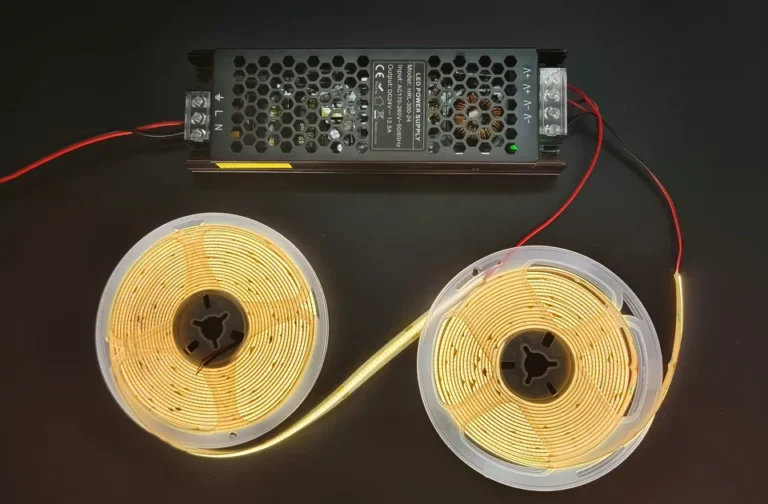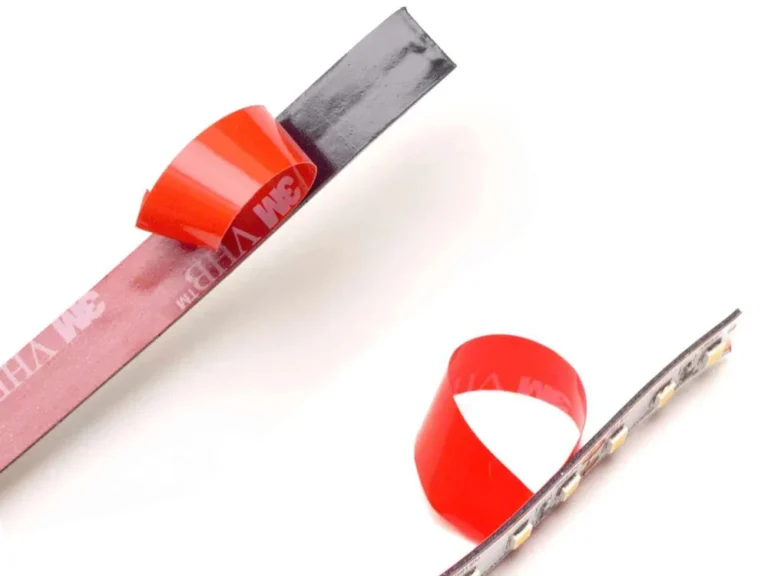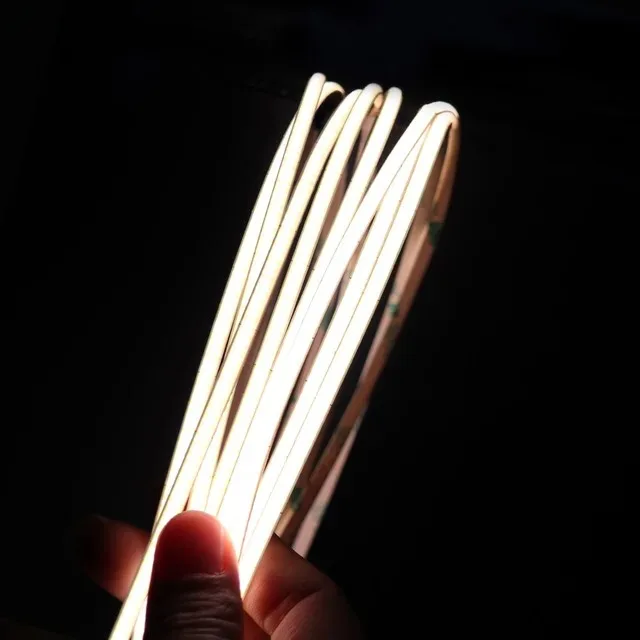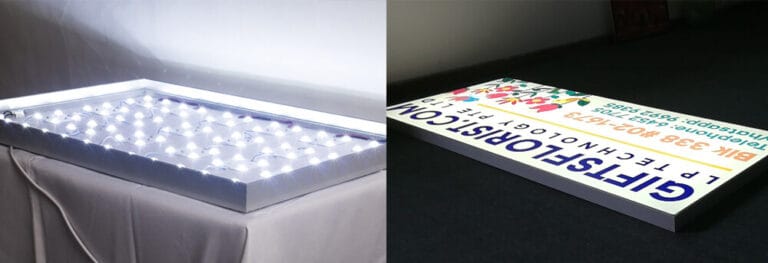Bij het plannen van een LED-verlichtingsproject, of het nu gaat om winkelpuien, gevels, kantoorverlichting of bewegwijzering, is het een cruciale stap om het stroomverbruik van LED-striplampen te begrijpen. Het helpt u niet alleen bij het selecteren van de juiste stroomvoorziening om overbelasting van het circuit te voorkomen, maar heeft ook invloed op het totale energiebudget van het project en de operationele kosten op lange termijn.
LED-stripverlichting, met hun energiezuinige kenmerken, hebben de traditionele verlichtingsmethoden geleidelijk vervangen. Bij daadwerkelijk gebruik wordt hun stroomverbruik echter beïnvloed door meerdere factoren, zoals vermogen per meter (W/m), ingangsspanning (bijv. 12V/24V), LED-dichtheid (aantal LED's) en dagelijkse gebruiksduur. Voor commerciële en industriële verlichtingsprojecten kan zelfs een verschil van enkele watt per meter op lange termijn leiden tot aanzienlijke elektriciteitskostenverschillen.
In deze uitgebreide gids zullen we een gedetailleerde analyse geven van:
- Hoe het stroomverbruik en de elektriciteitskosten van LED-lichtstrips (watt & kWh) te berekenen
- Factoren die het werkelijke stroomverbruik van lichtstrips beïnvloeden
- Vergelijking van stroomverbruiksverschillen tussen veelvoorkomende soorten LED-lichtstrips
- Hoe energiezuinige LED-lichtstrips te selecteren
- Real-world casestudies en energiebesparende aanbevelingen om de kosteneffectiviteit van het project te verbeteren
Vervolgens beginnen we met de basis: hoe wordt het stroomverbruik van LED-striplampen berekend?
Berekeningsmethoden en eenheid Toelichtingen voor LED-striplichtstroomverbruik
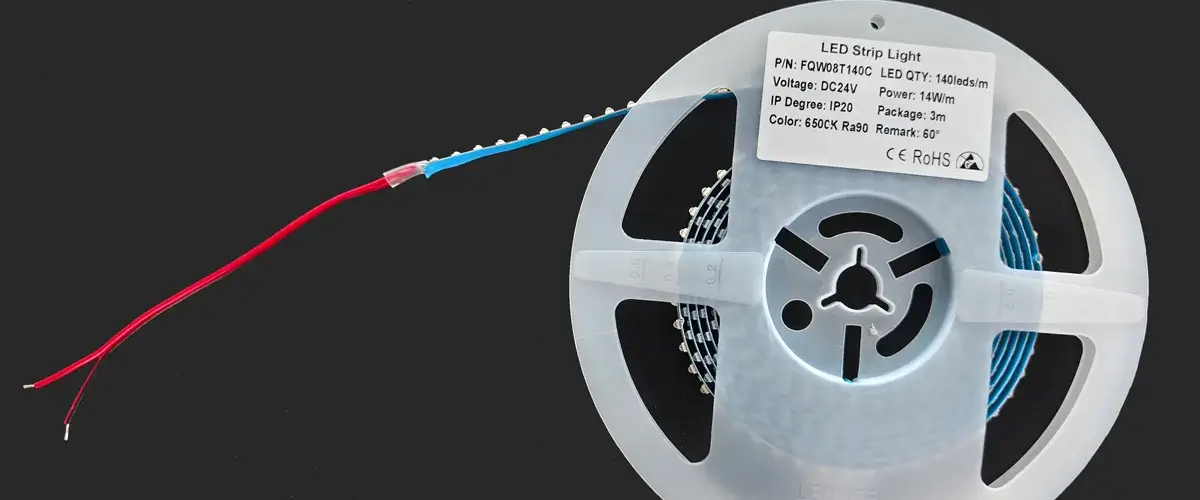
Om het stroomverbruik van LED-striplampen nauwkeurig te begrijpen, is het essentieel om eerst verschillende fundamentele concepten en eenheden te begrijpen, die van cruciaal belang zijn bij productselectie, systeemstroomdistributie en zelfs bieden en prijzen. Wil je meer leren? Lees onze blog: Complete gids voor LED-stripverlichting.
1. Vermogen (Watt, W) - de kernindicator voor energieverbruik
Het vermogen van LED-lichtstrips wordt meestal gemeten in "watt per meter (w/m)", wat het stroomverbruik per meter van de lichtstrip bij de nominale spanning aangeeft.
Een lichtstrip met een nominaal vermogen van 14,4 W/m en een lengte van 5 meter heeft bijvoorbeeld een bedrijfsvermogen van:
14,4 × 5 = 72W
Dit betekent dat de lichtstrip tijdens het gebruik 72 watt vermogen verbruikt per uur.
2. Spanning (V) - Bepaalt de huidige en bedradingsconfiguratie
Gemeenschappelijke bedrijfsspanningen voor LED-lichtstrips omvatten 12V, 24V en 48V. Hoewel de spanning geen invloed heeft op het totale stroomverbruik, bepaalt het de huidige grootte en lijnverliezen:
- Op hetzelfde vermogensniveau resulteert een hogere spanning in een lagere stroom en een lagere lijnspanningsval, waardoor het meer geschikt is voor bedrading over lange afstanden.
Bijvoorbeeld:
72W @ 12V → stroom = 6A
72W @ 24V → Stroom = 3A
Dit is vooral belangrijk voor commerciële verlichtingstoepassingen met lichtstrips die langer zijn dan 10 meter. Moet ik 12V of 24V LED-striplichten kiezen? Lees het blog: 12 V vs. 24 V LED Stripverlichting: Hoe kies je?
3. Elektriciteit Copsumption (kWh, kilowattuur)—A kods Iknipoog Afenomenig Etacticiteit Copen
Om de werkelijke elektriciteitskosten te schatten, moet stroom worden omgezet in "kilowatt-uren (kWh)", gewoonlijk "kWh" genoemd. De berekeningsformule is als volgt:
Elektriciteitsverbruik (kWh) = vermogen (W) × Gebruikstijd (uren) ÷ 1000
Voorbeeld: een LED-lichtstrip met een totaal vermogen van 72 W, 8 uur per dag gebruikt, 30 dagen per maand in gebruik:
Dagelijks elektriciteitsverbruik: 72 × 8 ÷ 1000 = 0,576 kWh
Maandelijks elektriciteitsverbruik: 0,576 × 30 = 17,28 kWh
Als het elektriciteitstarief $0,12 per kWh is, zou de maandelijkse elektriciteitsrekening ongeveer 17,28 × 0,12 = $2,07 zijn.
4. Lichtgevend Eficiacy (LM/W)—An Iinhoudelijk Indicator voor Einschatto Energie Eefficiëntie
Lichtgevende werkzaamheid verwijst naar het aantal lumen (lichtstroom) per watt vermogen, gemeten in lm/W. Voor commerciële toepassingen wordt aanbevolen om LED-lichtstrips te selecteren met een lichtrendement van ≥ 100 lm/W, wat de helderheid kan garanderen en tegelijkertijd het energieverbruik kan verminderen.
Door deze basisconcepten te begrijpen, kunt u het elektriciteitsverbruik van het project meer wetenschappelijk plannen en echt energiezuinige, kosteneffectieve LED-lichtstripoplossingen selecteren. Vervolgens zullen we ons verdiepen in de belangrijkste factoren die van invloed zijn op het stroomverbruik in praktische toepassingen.
Bekijk de video om te leren hoe u het stroomverbruik van LED-striplichten kunt berekenen.

Belangrijkste factoren die van invloed zijn op het stroomverbruik van LED-striplicht
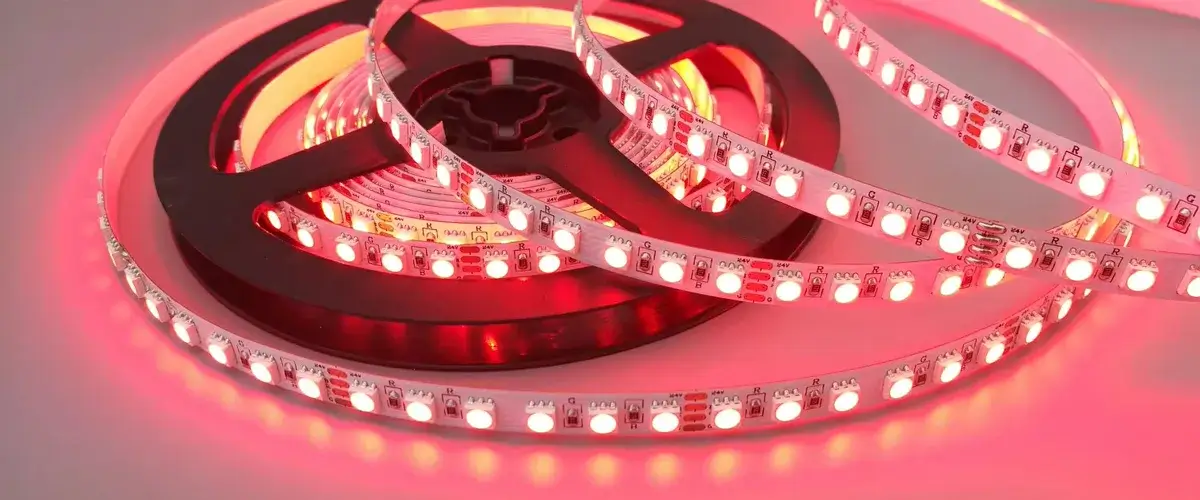
Hoewel het nominale vermogen van LED-striplampen een belangrijke maatstaf is, wordt het werkelijke stroomverbruik in real-world toepassingen vaak beïnvloed door een combinatie van meerdere factoren. Het begrijpen van deze variabelen kan helpen bij het nauwkeurig beoordelen van de bedrijfskosten en het elektrische ontwerp van het project.
1. LED-dichtheid (LED's per meter)
Hoe meer LED's per meter, hoe hoger het stroomverbruik per meter en hoe helderder het licht.
| LED-dichtheid | Gemeenschappelijk vermogensbereik | Toepassingsscenario's |
| 30 LED's/m | 4,8–7,2 W/m | Kast interieur sfeerverlichting, zachte verlichting |
| 60 LED's/m | 9,6–14,4 W/m | Advertentielichtkasten, raam achtergrondverlichting |
| 120 LED's/m | 18-24 W/m | Hoog-helderheid hoofdverlichting, displayverlichting |
2. Kleurtemperatuur en kleurtypen
- Monochrome lichtstrips (bijv. 3000K warm wit of 6000K koelwit) hebben over het algemeen een lager stroomverbruik. (Wilt u meer weten over de verschillen tussen deze kleurtemperaturen? Lees onze blogpost: 3000K versus 4000K versus 5000K versus 6000K: wat is het verschil?)
- RGB- of RGBW-lichtstrips bevatten doorgaans meerdere chips, wat resulteert in een aanzienlijk hoger vermogen per lengte van een eenheid; RGBW-lichtstrips kunnen zelfs meer dan 20 W/m bedragen.
Bovendien varieert de lichtopbrengst (LM/W) van LED's met verschillende lichtkleuren; bijvoorbeeld koel wit licht heeft doorgaans een hoger lichtrendement dan rood of blauw licht.
3. Spanningswaarden: 12V versus 24V versus 48V
- Hoewel de spanning zelf geen stroomverbruik bepaalt, heeft het direct invloed op de huidige grootte en lijnverliezen.
- Voor bedrading van meer dan 5 meter of commerciële toepassingen bieden 24V- of 48V-systemen voordelen, waardoor de spanningsval effectief wordt verminderd en de energie-efficiëntie wordt verbeterd.
4. Dimregeling en bedrijfsmodi
wanneer Dimregelaars (zoals PWM-dimmen, 0-10V dimmen of DMX-regeling) worden geïntroduceerd, LED-strips werken niet altijd bij 100%-helderheid, wat resulteert in een lager gemiddeld stroomverbruik.
Het verminderen van de helderheid tot 70% met behulp van PWM-besturing resulteert bijvoorbeeld in een overeenkomstige 30%-vermindering van het werkelijke stroomverbruik.
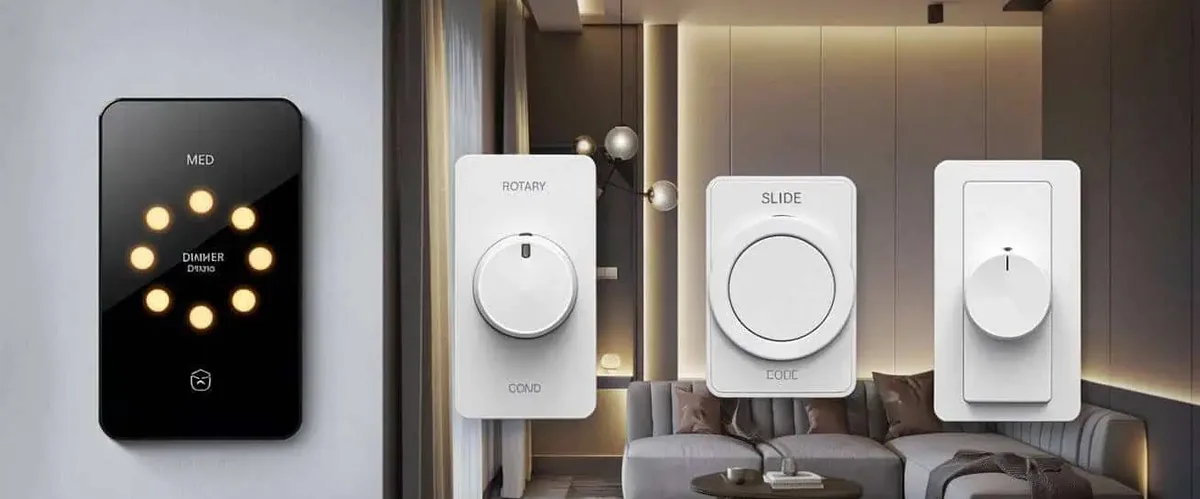
5. Operationele omgeving en warmteafvoeromstandigheden
Hoge temperatuuromgevingen of slechte warmteafvoer kunnen de lichtopbrengst en elektrische efficiëntie van LED-chips verminderen, wat mogelijk kan leiden tot abnormaal energieverbruik.
- Wanneer geïnstalleerd in gesloten aluminium kanalen, kastinterieurs of buitenverzegelde omgevingen, wordt het aanbevolen om te gebruiken LED aluminium profielen Voor warmteafvoeroptimalisatie.
- Voor elke 10°C stijging van de omgevingstemperatuur kunnen de LED-prestaties met meer dan 51 TP3T afnemen.
6. Gebruiksduur en frequentie
- Commerciële LED-strips die meer dan 10 uur per dag werken, zullen resulteren in aanzienlijk hogere maandelijkse elektriciteitskosten in vergelijking met scenario's voor kort gebruik in woningen.
- Voor 24/7 operatiescenario's (zoals gemakswinkels of bewegwijzering van een keten), kan het selecteren van hoogrenderende, energiezuinige modellen de elektriciteitskosten op lange termijn aanzienlijk verminderen.
Samenvattend is het stroomverbruik van LED-striplicht niet alleen een nominale "W/M" -parameter, maar een dynamische systeemvariabele. Het redelijkerwijs beoordelen van deze factoren kan u helpen om het energieverbruik en de budgetdruk vanaf het begin van het project te beheersen.
Stroomverbruik Vergelijking van verschillende soorten LED-striplampen
In echte projecten omvat het selecteren van LED-striplampen vaak het balanceren van helderheid, stroomverbruik en prestaties. LED-striplampen met verschillende verpakkingsspecificaties, verlichtingsmethoden en functionele toepassingen vertonen significante verschillen in stroomverbruik per eenheid. Het volgende is een typische vergelijking van het stroomverbruik van verschillende reguliere soorten LED-striplampen.
Gemeenschappelijke LED-strip stroomverbruik parameters in één oogopslag
| Type licht strip | Spanning | LED Dichtheid | Stroom | Lichtefficiëntie (LM/W) | Toepassingsscenario's |
| 3528 mono-lichtstrip | DC12V/24V | 60 LED's/m | 4,8W/m | 80-100 | Ambient verlichting, thuisverlichting |
| 5050 RGB-lichtstrip | DC12V/24V | 60 LED's/m | 14,4W/m | 60-75 | Dynamische decoratie, meerkleurenbesturing |
| 2835 LED-strip met hoge helderheid | DC24V | 120 LED's/m | 19,2W/m | 100-120 | Commerciële verlichting, hoofdlichtbron in de detailhandel |
| COB LED-strip | DC24V | 480 LED's/m | 11W/m | 100-110 | Geen donkere zone-applicaties, raamachtergrondverlichting |
| RGBW 4-in-1 Led-strip | DC24V | 60 LED's/m | 18–20 W/m | 50-65 | Contourverlichting buiten, veelkleurige scèneverlichting |
Selectie-aanbevelingen (op basis van projectvereisten):
- Focus op energie-efficiëntie → Kies LED-striplampen met een lichtrendement van meer dan 100 lm/W, of monochromatisch of COB LED-stripverlichting.
- Meerkleurige dynamische effecten vereisen → Overweeg digitaal adresseerbare RGB- of RGBW-LED-striplichten, maar let op het verhoogde totale stroomverbruik.
- Op zoek naar uniforme lichtefficiëntie en het afwijzen van puntachtige verlichting → COB LED-lichtstrips zijn de ideale keuze.
- Voor lineaire verlichting over lange afstand → Prioriteer 24V of 48V LED-lichtstrips met lange afstand om de spanningsval te verminderen.
Door deze vergelijkingen kunt u intuïtievere LED-lichtstrips selecteren die de prestaties en het stroomverbruik in evenwicht brengen, waarbij problemen zoals overspecificatie, snel lichtverval of hoge elektriciteitskosten worden vermeden. Lees de blog voor meer informatie over het kiezen en kopen van LED-striplampen: De complete gids voor het kopen van LED-stripverlichting.
Energiebesparende optimalisatieaanbevelingen voor commerciële toepassingen
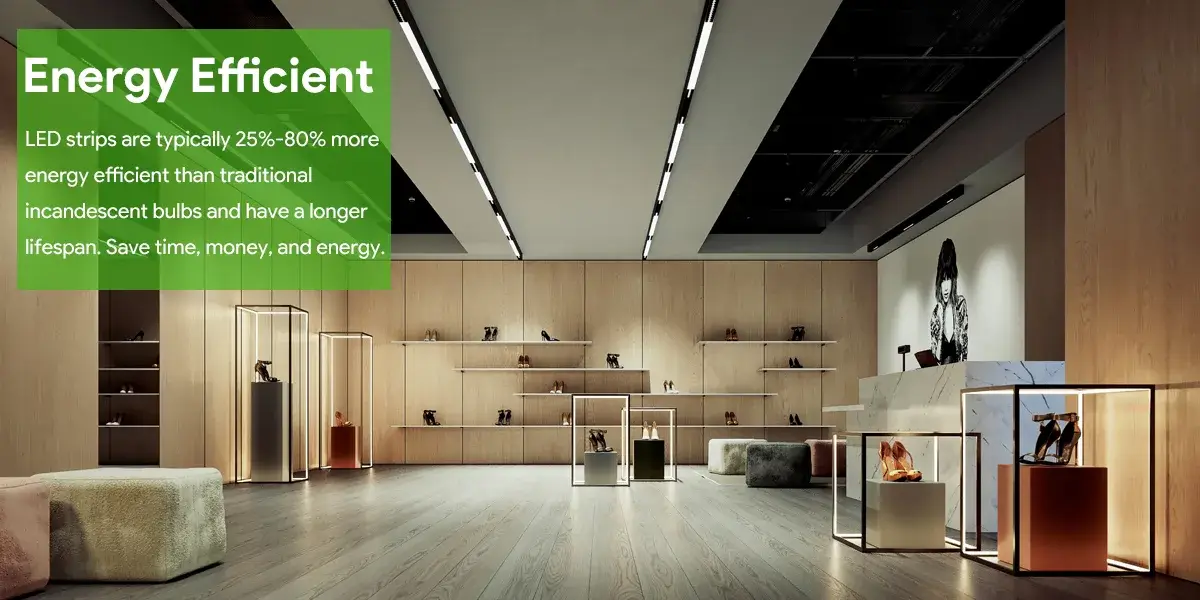
In commerciële en industriële verlichtingstoepassingen werken LED-lichtstrips vaak voor lange tijd, omvatten complexe bedrading en worden in diverse omgevingen gebruikt. Zelfs kleine configuratiefouten kunnen leiden tot energieverspilling of een kortere levensduur. Hieronder volgen enkele bewezen energiebesparende strategieën die u kunnen helpen een hogere energie-efficiëntie en lagere bedrijfs- en onderhoudskosten in uw projecten te bereiken.
1. Geef prioriteit aan hoogefficiënte, hoogwaardige producten (≥100 lm/W).
Hogere lichtgevende werkzaamheid betekent een lager stroomverbruik voor dezelfde helderheid. Een lichtstrip van 100 lm/W vereist bijvoorbeeld slechts 10 W om 1000 lumen te bereiken, terwijl een 80 lm/W lichtstrip mogelijk 12,5 W nodig heeft, wat resulteert in een significant verschil over langdurige werking.
Tip: prioriteit geven aan het gebruik van 2835 LED-strip met hoge helderheid of COB LED-strip, die superieure lichtgevende werkzaamheid en betere warmteafvoer bieden.
2. Reeds redelijke LED-striplengte plannen om overspeculatie of afval te voorkomen.
- Bereken het vermogen op basis van de werkelijke lengte om "overreservering" te voorkomen, wat leidt tot overmatig energieverbruik.
- Voor lineaire structuren of contourverlichtingsprojecten wordt aanbevolen om de vereiste lengte nauwkeurig te meten op basis van CAD-tekeningen.
Tip: Overtollige LED-strips kunnen worden opgenomen in zoneregelingssystemen of op maat worden gesneden om onnodig energieverbruik te verminderen.
3. Optimaliseer de stroomvoorziening en de bedradingsstructuur om spanningsverliezen te minimaliseren.
- chic Hoogrendementsvoedingen met constante spanning (Conversie-efficiëntie ≥ 90%) Compatibel met de LED-strips.
- Gebruik voldoende dikke koperdraden om te voorkomen dat Spanningsdalingen en een verhoogd energieverbruik veroorzaakt door langeafstandstransmissie.
- Voor projecten met bedradingsafstanden van meer dan 10 meter wordt aanbevolen om een DC24V- of DC48V-systeem te gebruiken.
Voorbeeld: In een bedrading van 15 meter kan een DC12V-systeem een ongelijke helderheid ervaren als gevolg van spanningsval, terwijl een DC24V-systeem dit probleem effectief kan oplossen.
4. Implementeer dim-/slimme besturingssystemen.
Dimmen verbetert niet alleen de sfeer en visuele ervaring, maar vermindert ook direct het stroomverbruik. Typische controlemethoden zijn onder meer:
- PWM dimmen (geschikt voor binnenshuis/track verlichtingssystemen)
- 0–10 V dimmen (geschikt voor commerciële kantoorverlichting)
- DMX-besturing (geschikt voor RGB-dynamische projecten)
- Timer + sensorbesturing (geschikt voor openbare ruimtes, tentoonstellingshallen, enz.)
Dimmen gegevensreferentie: Wanneer gedimd tot 70% helderheid, kan het werkelijke stroomverbruik met ongeveer 301 TP3T worden verminderd.
5. Combineer met aluminium profielen of warmtegeleidende substraten om de efficiëntie van de warmteafvoer te verbeteren.
Effectieve warmteafvoer verlengt niet alleen de levensduur van de LED-strip, maar verbetert ook de efficiëntie van het circuit en vermindert stroomverlies. Aanbevolen combinaties:
- U-vormige/geembedde aluminium profielen + diffusordeksels
- Gebruik voor buiteninstallaties waterdichte aluminium kanalen en zorg voor een goed luchtstroomontwerp.
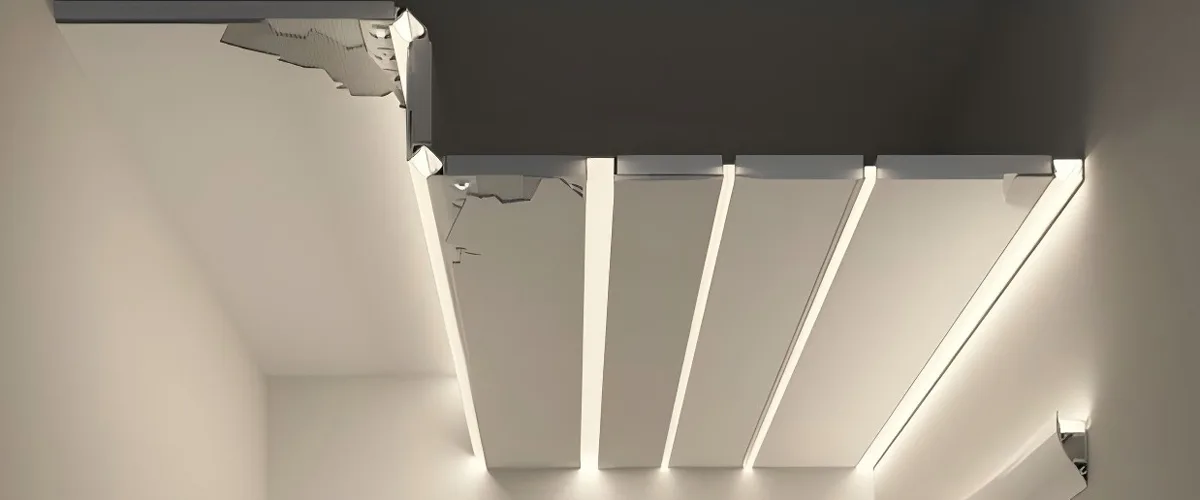
6. Regelmatig onderhoud uitvoeren.
Stof en vuil kunnen zich na verloop van tijd op LED-lichtstrips ophopen, waardoor de helderheid en efficiëntie ervan worden verminderd. Regelmatige reiniging zorgt ervoor dat ze optimale prestaties behouden. Inspecteer bovendien regelmatig verbindingen en stroombronnen om er zeker van te zijn dat ze goed werken.
Door de bovenstaande strategieën te implementeren, kunt u niet alleen de totale elektriciteitskosten verminderen, maar ook de stabiliteit en levensduur van het hele LED-lichtstripverlichtingssysteem verbeteren, waardoor de frequentie en budgettoewijzing voor toekomstig onderhoud worden geminimaliseerd.
Real-world applicatiegevallen en berekeningsvoorbeelden voor stroomverbruik
Om een intuïtiever inzicht te krijgen in de stroomverbruiksprestaties van LED-lichtstrips, gebruiken we drie veelvoorkomende commerciële verlichtingsscenario's als voorbeelden om gedetailleerde schattingen van elektriciteitsverbruik en elektriciteitskosten uit te voeren en deze te vergelijken met energiebesparende oplossingen.
Case 1: Kledingwinkel raamverlichting (met mono COB lichtstrips)
Specificaties lichtstrip: 24V COB lichtstrip, 14W/m, lichtgevend werk 100 lm/W
Installatielengte: 10 meter
Gemiddelde dagelijkse bedrijfstijd: 10 uur
Bedrijfscyclus: 30 dagen/maand
Referentie elektriciteitstarief: $0.12/kWh
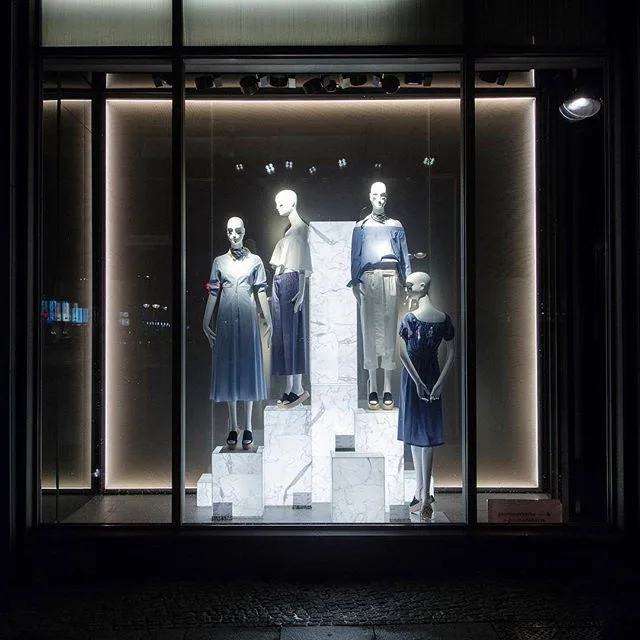
Berekening van het stroomverbruik:
Totaal vermogen = 14W × 10 meter = 140 W
Dagelijks elektriciteitsverbruik = 140W × 10 uur ÷ 1000 = 1,4 kWh
Maandelijks elektriciteitsverbruik = 1,4 × 30 = 42 kWh
Maandelijkse elektriciteitskosten = 42 × $0.12 = $5.04
Jaarlijkse elektriciteitskosten = $5.04 × 12 = $60.48
Energiebesparende optimalisatie:
Als een Hoge helderheid 2835 LED-strip Met een hogere lichtopbrengst (bijv. 190 lm/W) wordt het stroomverbruik slechts 12 W/m gereduceerd, waardoor de maandelijkse elektriciteitsrekening wordt verlaagd tot $4.32 en jaarlijks meer dan $8.64 per armatuur wordt bespaard.
Case 2: Mall Corridor Contourverlichting (met RGB LED-strips)
Specificaties LED-strip: 24V RGB LED-strip, 14,4 W/m
Installatielengte: 30 meter
Gemiddelde dagelijkse gebruikstijd: 12 uur (automatische getimede regeling)
Bedrijfscyclus: het hele jaar door
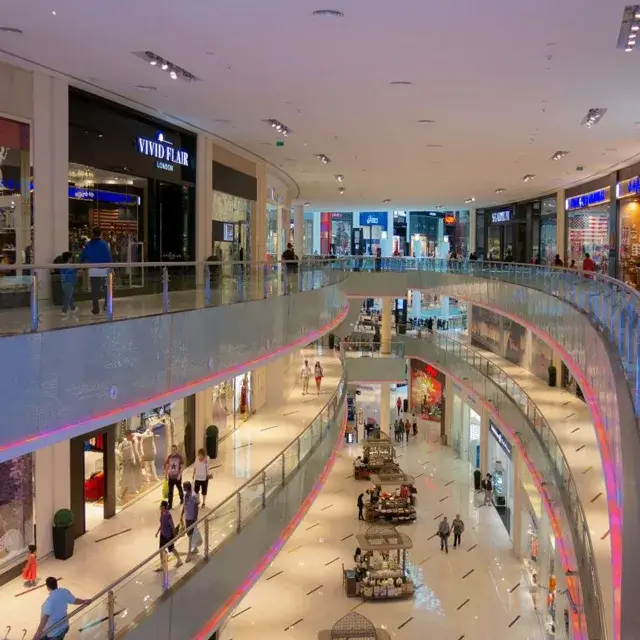
Berekening van het stroomverbruik:
Totaal vermogen = 14,4W × 30 meter = 432W
Dagelijks elektriciteitsverbruik = 432 × 12 ÷ 1000 = 5,18 kWh
Jaarlijks elektriciteitsverbruik = 5,18 × 365 ≈ 1.891,7 kWh
Jaarlijkse elektriciteitskosten $227,00
Energiebesparende optimalisatie:
Door de DMX-dimregeling te introduceren, met een gemiddelde helderheid van 70% op basis van de werkelijke werking, wordt het totale stroomverbruik teruggebracht tot 302W en daalt de jaarlijkse elektriciteitskosten tot ongeveer $158.70, wat $68+/jaar/locatie bespaart.
Case 3: Kantoorplafondverlichting (ingebouwde lineaire lichtstrip)
Specificaties lichtstrip: 24V High-Helderheid 2835 Lichtstrook, 18W/m, CRI > 90
Totale installatielengte: 50 meter
Gebruikstijd: 8 uur per dag, op werkdagen (22 dagen per maand)
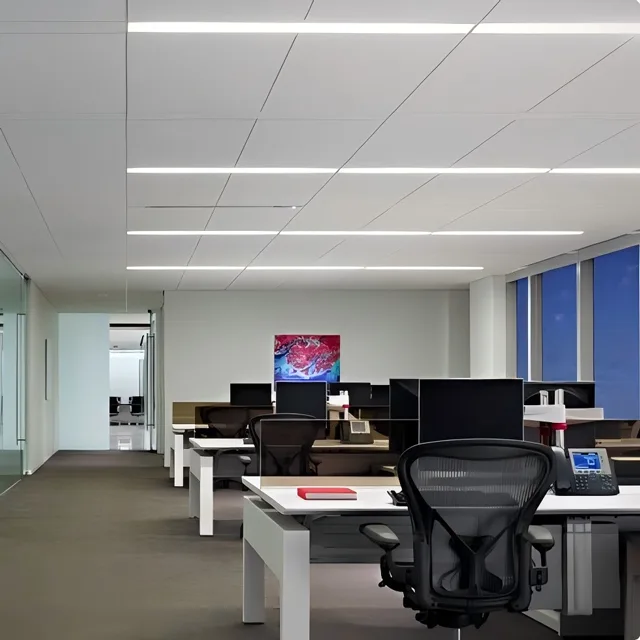
Berekening van het stroomverbruik:
Totaal vermogen = 18 × 50 = 900 W
Maandelijks elektriciteitsverbruik = 900 × 8 × 22 ÷ 1000 = 158,4 kWh
Maandelijkse elektriciteitskosten = 158,4 × $0.12 = $19.01
Jaarlijkse elektriciteitskosten = $19,01 × 12 = $228.12
Energiebesparende optimalisatie:
- Optimaliseren tot een 130 lm/W COB lichtstrip met een hogere efficiëntie, waarbij slechts 8W per meter → jaarlijkse elektriciteitskostenbesparing van ongeveer $120+ nodig is.
- Installeer een 0-10V dimsysteem om de helderheid aan te passen op basis van natuurlijk licht, wat een groter energiebesparend potentieel biedt.
Samenvatting:
| plaats van handeling | Originele jaarlijkse elektriciteitskosten | Jaarlijkse elektriciteitskosten na energiebesparende optimalisatie | Jaarlijkse elektriciteitskostenbesparing |
| raamverlichting | $60.48 | $51.84 | $8.64 |
| Mall overzicht verlichting | $227.00 | $158.70 | $68.30 |
| kantoor hoofdverlichting | $228.12 | $101.37 (geschat) | $126.75 |
Voor middelgrote tot grootschalige projecten kan zelfs een energiebesparing van 2 W per meter resulteren in aanzienlijke operationele kostenoptimalisaties wanneer ze worden geaccumuleerd.
FAQ
In vergelijking met traditionele verlichting hebben LED-lichtstrips al een zeer laag energieverbruik. Als voorbeeld een 12W/m LED-lichtstrip met een lengte van 10 meter, zelfs als deze 24 uur per dag aan staat, is het dagelijkse elektriciteitsverbruik slechts 2,88 kWh. Met een elektriciteitstarief van $0.12/kWh bedragen de dagelijkse elektriciteitskosten ongeveer $0.35. Als echter een groot aantal strips wordt ingezet en voor langere tijd wordt bewaard, wordt het nog steeds aanbevolen om timing- of dimbesturing op te nemen om het energieverbruik verder te verminderen.
Theoretisch gezien is het stroomverbruik van 12V en 24V LED-strips hetzelfde onder hetzelfde vermogen (bijv. 14,4 W/m). Omdat het 12V-systeem echter een hogere stroom heeft, is het meer gevoelig voor spanningsval en warmteverlies tijdens lange afstandsbedrading, waardoor de efficiëntie wordt verminderd en het energieverbruik wordt verhoogd. Voor toepassingen van meer dan 5 meter of commercieel gebruik wordt aanbevolen om een 24V- of 48V-systeem te gebruiken.
Ja. Elke LED-module in een RGB LED-strip bevat meestal drie kleurenchips (rood, groen en blauw), wat resulteert in een hoger stroomverbruik. RGBW LED-strips bevatten ook een extra wit lichtchip, waarbij het stroomverbruik mogelijk 18-20 W/m bereikt. Monochrome LED-strips hebben doorgaans een vermogen tussen 4,8 en 12 W/m. Als energie-efficiëntie een prioriteit is, moeten RGB-gebruiksgebieden redelijk worden gepland.
Ja. Het wordt aanbevolen om een socket-gemonteerde vermogensmeter of vermogensmeter bij de stroombron te gebruiken met kilowattuur (kWh) metingen om het realtime stroom-, cumulatief elektriciteitsverbruik en geschatte elektriciteitskosten van het hele systeem direct te meten. Dit is zeer geschikt voor testen op locatie en energie-efficiëntiebeoordelingen.
Ja, vooral met dimmethoden zoals PWM, 0-10V, DALI en DMX. Wanneer de helderheid wordt verminderd, neemt de stroom synchroon af en neemt ook het stroomverbruik af. Als u bijvoorbeeld de helderheid van de lichtstrip op 70% instelt, wordt het stroomverbruik met ongeveer 301 TP3T verminderd, het verlengt ook de levensduur van de verlichtingsarmaturen en vermindert de onderhoudsfrequentie.
Conclusie: Waarom kiezen voor Signlitetles hoogefficiënte LED-striplampen?
In de huidige verlichtingsmarkt, die prioriteit geeft aan energie-efficiëntie en milieubescherming, is energiebesparing niet alleen een trend, maar ook een cruciale garantie voor projectbudgetbeheersing en rendement op lange termijn. In dit artikel hebben we de factoren die van invloed zijn op de factoren die van invloed zijn op het stroomverbruik van LED-strips en energiebesparende optimalisatiestrategieën uitgebreid geanalyseerd, van basisberekeningen tot real-world casestudies.
SignLiteled zet zich in om klanten te voorzien van:
- Hoogrendementsvermogen (100-200 lm/W) LED-striplichtoplossingen om het energieverbruik per meter te verminderen
- Precieze power matching en power supply ontwerpdiensten om overbelasting en afval te voorkomen
- Compatibiliteit met slimme besturing voor eenvoudig dimmen en zone-gebaseerde energiebesparingen
- Projectspecifieke maatwerkondersteuning om te voldoen aan de balans tussen lichtgevende werkzaamheid en energieverbruik in verschillende scenario's
Als u op zoek bent LED-stripverlichting Die balanshelderheid, levensduur en energie-efficiëntie, neem contact met ons op om testmonsters of een-op-een technische ondersteuning aan te vragen.
